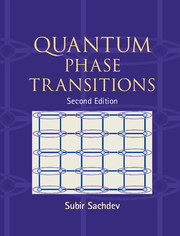Book contents
- Frontmatter
- Contents
- From the Preface to the first edition
- Preface to the second edition
- Part I Introduction
- Part II A first course
- 3 Classical phase transitions
- 4 The renormalization group
- 5 The quantum Ising model
- 6 The quantum rotor model
- 7 Correlations, susceptibilities, and the quantum critical point
- 8 Broken symmetries
- 9 Boson Hubbard model
- Part III Nonzero temperatures
- Part IV Other models
- References
- Index
9 - Boson Hubbard model
from Part II - A first course
Published online by Cambridge University Press: 16 May 2011
- Frontmatter
- Contents
- From the Preface to the first edition
- Preface to the second edition
- Part I Introduction
- Part II A first course
- 3 Classical phase transitions
- 4 The renormalization group
- 5 The quantum Ising model
- 6 The quantum rotor model
- 7 Correlations, susceptibilities, and the quantum critical point
- 8 Broken symmetries
- 9 Boson Hubbard model
- Part III Nonzero temperatures
- Part IV Other models
- References
- Index
Summary
This chapter finally moves beyond the quantum rotor models which have been the complete focus of our attention so far in Part II. Our motivation is two-fold: to introduce the coherent state path integral, which plays an important role in developing the field theory for many interesting quantum phase transitions; and to provide a deeper and more complete explanation of our claimed connection between the N = 2 rotor model and the experiments on ultracold bosonic atoms in an optical lattice which was claimed in Sections 1.3 and 1.4.3. We do this by studying the boson Hubbard model, which has a direct connection to the microscopic Hamiltonian of the ultracold atoms.
The Hubbard model was originally introduced as a description of the motion of electrons in transition metals, with the motivation of understanding their magnetic properties. This original model remains a very active subject of research today, and important progress has been made in recent years by examining its properties in the limit of large spatial dimensionality [160, 165].
In this chapter, we examine only the much simpler “boson Hubbard model,” following the analysis in an important paper by Fisher et al. [148]. As the name implies, the elementary degrees of freedom in this model are spinless bosons, which take the place of the spin-1/2 fermionic electrons in the original Hubbard model. These bosons could represent Cooper pairs of electrons undergoing Josephson tunneling between superconducting islands, helium atoms moving on a substrate, or ultracold atoms in an optical lattice.
- Type
- Chapter
- Information
- Quantum Phase Transitions , pp. 117 - 132Publisher: Cambridge University PressPrint publication year: 2011



